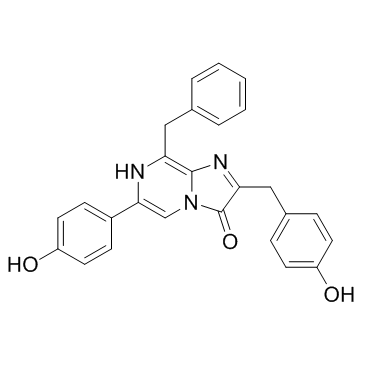Coelenterazine

Coelenterazine structure
|
Common Name | Coelenterazine | ||
|---|---|---|---|---|
| CAS Number | 55779-48-1 | Molecular Weight | 423.463 | |
| Density | 1.3±0.1 g/cm3 | Boiling Point | 641.4±65.0 °C at 760 mmHg | |
| Molecular Formula | C26H21N3O3 | Melting Point | N/A | |
| MSDS | Chinese USA | Flash Point | 341.7±34.3 °C | |
|
Rp-cAMPS Prodrugs Reveal the cAMP Dependence of First-Phase Glucose-Stimulated Insulin Secretion.
Mol. Endocrinol. 29 , 988-1005, (2015) cAMP-elevating agents such as the incretin hormone glucagon-like peptide-1 potentiate glucose-stimulated insulin secretion (GSIS) from pancreatic β-cells. However, a debate has existed since the 1970s concerning whether or not cAMP signaling is essential for ... |
|
|
Fluorophore-NanoLuc BRET Reporters Enable Sensitive In Vivo Optical Imaging and Flow Cytometry for Monitoring Tumorigenesis.
Cancer Res. 75 , 5023-33, (2015) Fluorescent proteins are widely used to study molecular and cellular events, yet this traditionally relies on delivery of excitation light, which can trigger autofluorescence, photoxicity, and photobleaching, impairing their use in vivo. Accordingly, chemilum... |
|
|
A Novel Mutation in Isoform 3 of the Plasma Membrane Ca2+ Pump Impairs Cellular Ca2+ Homeostasis in a Patient with Cerebellar Ataxia and Laminin Subunit 1α Mutations.
J. Biol. Chem. 290 , 16132-41, (2015) The particular importance of Ca(2+) signaling to neurons demands its precise regulation within their cytoplasm. Isoform 3 of the plasma membrane Ca(2+) ATPase (the PMCA3 pump), which is highly expressed in brain and cerebellum, plays an important role in the ... |
|
|
Aerobic glycolysis tunes YAP/TAZ transcriptional activity.
EMBO J. 34 , 1349-70, (2015) Increased glucose metabolism and reprogramming toward aerobic glycolysis are a hallmark of cancer cells, meeting their metabolic needs for sustained cell proliferation. Metabolic reprogramming is usually considered as a downstream consequence of tumor develop... |
|
|
Postinfarction Functional Recovery Driven by a Three-Dimensional Engineered Fibrin Patch Composed of Human Umbilical Cord Blood-Derived Mesenchymal Stem Cells.
Stem Cells Transl. Med. 4 , 956-66, (2015) Considerable research has been dedicated to restoring myocardial cell slippage and limiting ventricular remodeling after myocardial infarction (MI). We examined the ability of a three-dimensional (3D) engineered fibrin patch filled with human umbilical cord b... |
|
|
Serine-727 phosphorylation activates hypothalamic STAT-3 independently from tyrosine-705 phosphorylation.
Mol. Endocrinol. 29(3) , 445-59, (2015) Transcriptional activity of signal transducer and activator of transcription-3 (STAT-3) is a key element in the central regulation of appetite and energy homeostasis. Activation of hypothalamic STAT-3 has been attributed to cytokine-promoted phosphorylation a... |
|
|
Targeting the cis-dimerization of LINGO-1 with low MW compounds affects its downstream signalling.
Br. J. Pharmacol. 172(3) , 841-56, (2015) The transmembrane protein LINGO-1 is a negative regulator in the nervous system mainly affecting axonal regeneration, neuronal survival, oligodendrocyte differentiation and myelination. However, the molecular mechanisms regulating its functions are poorly und... |
|
|
The atypical antidepressant and neurorestorative agent tianeptine is a μ-opioid receptor agonist.
Transl. Psychiatry 4 , e411, (2014) Current pharmacological treatments of depression and related disorders suffer from major problems, such as a low rate of response, slow onset of therapeutic effects, loss of efficacy over time and serious side effects. Therefore, there is an urgent need to ex... |
|
|
Functional selectivity of allosteric interactions within G protein-coupled receptor oligomers: the dopamine D1-D3 receptor heterotetramer.
Mol. Pharmacol. 86(4) , 417-29, (2014) The dopamine D1 receptor-D3 receptor (D1R-D3R) heteromer is being considered as a potential therapeutic target for neuropsychiatric disorders. Previous studies suggested that this heteromer could be involved in the ability of D3R agonists to potentiate locomo... |
|
|
Discovery and validation of small-molecule heat-shock protein 90 inhibitors through multimodality molecular imaging in living subjects.
Proc. Natl. Acad. Sci. U. S. A. 109(37) , E2476-85, (2012) Up-regulation of the folding machinery of the heat-shock protein 90 (Hsp90) chaperone protein is crucial for cancer progression. The two Hsp90 isoforms (α and β) play different roles in response to chemotherapy. To identify isoform-selective inhibitors of Hsp... |